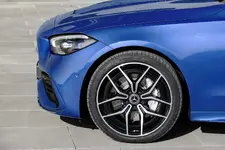Interesting info from JESMB about the new C-class chassis. Air-Matic is no longer been offered on the C-class. Maybe to save costs?
The chassis of the new Mercedes C-Class
The new C-Class, including rear-axle steering, offers new chassis options
The new Mercedes C-Class W206 should manage the balancing act between comfort and agility even better than its already very good predecessor W205.
The optional Airmatic air suspension is no longer required, but this was due to the fact that customers hardly ever ordered it, which meant that development costs and the provision of spare parts, including employee training, became too expensive. In 2014, the Airmatic's take rate was 6%. In 2020 the Airmatic order rate was only 1%.
And about the new details of the 206 chassis:
The main components of the new, dynamically designed chassis are a new four-link axle at the front and a multi-link rear axle that is suspended from a subframe. The new chassis forms the basis for suspension, rolling and noise comfort, agile driving characteristics and driving pleasure. On request, the new C-Class can also be supplied with continuously adjustable damping and with a sports suspension. In the plug-in hybrids of both the sedan and the T-model , air suspension is standard on the rear axle (due to the heavy battery on the rear axle)
The rear axle steering: more manageable and dynamic
The new C-Class is particularly agile and stable at the same time with the optional rear-axle steering and the more direct steering ratio on the front axle combined with it. The steering angle on the rear axle is 2.5 degrees. This reduces the turning circle by 43 centimeters to 10.64 meters. This makes the W206 more manageable than the much more compact W202 from 1993 with its recirculating ball steering with a turning circle of 10.70 m.
The rear-axle steering is, however, a bit simpler than that of the big brother of the S-Class. There the rear wheels can turn up to 10 degrees instead of up to 2.5 degrees . And creates a turning circle of 10.5 m as a minimum.
Fewer turns to full lock
In addition, the driver also needs fewer turns of the steering wheel to fully lock it. With rear-axle steering, regardless of the drive concept, it is 2.1 instead of 2.35 (rear-wheel drive with comfort steering) or 2.3 turns (4MATIC versions with comfort steering).
At speeds of less than 60 km / h, the rear wheels steer in the opposite direction to the front wheels - when parking by up to 2.5 ° against the front axle angle. Depending on the situation, the wheelbase is virtually shortened, making the vehicle more manoeuvrable, light-footed and more agile. From a speed of more than 60 km / h, the rear wheels steer up to 2.5 ° in the same direction as the front wheels. The virtual longer wheelbase as a result offers noticeable advantages: increased driving stability and driving safety at high speeds, quick lane changes or sudden evasive maneuvers.
In addition, with dynamic maneuvers, such as when driving on a country road, significantly less steering angle is required - and the vehicle reacts more sportily to steering commands. This is supported by the integrated driving dynamics control of the ESP®.

